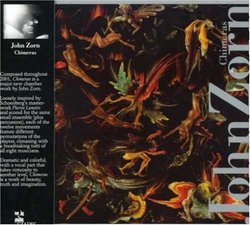| All Artists: John Zorn, Bradley Lubman, Elizabeth Farnum, Ilana Davidson Title: John Zorn: Chimeras Members Wishing: 2 Total Copies: 0 Label: Tzadik Original Release Date: 1/1/2003 Re-Release Date: 4/22/2003 Genres: Jazz, Classical Styles: Avant Garde & Free Jazz, Chamber Music, Historical Periods, Classical (c.1770-1830), Modern, 20th, & 21st Century Number of Discs: 1 SwapaCD Credits: 1 UPC: 702397708520 |
Search - John Zorn, Bradley Lubman, Elizabeth Farnum :: John Zorn: Chimeras
 | John Zorn, Bradley Lubman, Elizabeth Farnum John Zorn: Chimeras Genres: Jazz, Classical
|
Larger Image |
CD Details |
CD Reviews"A child's adventures in the realms of the unreal". Michael Stack | North Chelmsford, MA USA | 12/20/2005 (3 out of 5 stars) "A highly unusual composition, even for John Zorn, "Chimeras" consists of twelve movements (and one interlude) scored for sextet plus voice. Each movement pits the vocalist (primarily soprano Ilana Davidson, joined by Elizabeth Farnum on two movements) against some combination of the accompaniment-- two reeds (Tara O'Connor on flutes, Mike Lowenstern on clarinet), two strings (Jennifer Choi on violin and Fred Sherry on cello), keyboard (Stephen Drury, performing at piano, organ, and celesta) and percussion (William Winant). The music is loosely influenced by Schoenberg's "Pierrot Lunaire", with the same instrumentatal arrangement but with percussion added), but it's probably the cover, a reproduction of a painting by Heironymous Bosch, that best sums up what's held inside. Zorn subtitled the piece "A Child's Adventures in the Realms of the Unreal", and perhaps this is an accurate assessment. The movements find the vocalist in a number of contexts, sometimes framing, sometimes supporting, sometimes leading-- everything from frantic piano-violin-cello trios to delicate percussion, droning organs and bass flute, horn-and-strings, and so on provide shifting colors against which the vocal works. A couple instrumental passages serve as almost a deep breath (particularly the percussion only interlude) in the midst of this. When it's over, honestly, I'm left with not much feeling. It's an excessively difficult piece, and I can't really say I got much from it. Given that I've found much of Zorn's classical work to be moving, this always sort of disappoints me. Having said that, I find the experience of listening to this one oddly compelling (and curiously enough, it seems to raise my productivity at work), and as such, I tend to listen to it a lot. I may change my mind in the future, but for now I'll call this three stars. If you're into Zorn's classical work, it's well worth the investment." World of illusions. Lord Chimp | Monkey World | 06/08/2004 (5 out of 5 stars) "John Zorn's most recent entry to his New Composers series is one that succeeds on multiple levels. It is a genuinely disconcerting sonic experience. The internal mechanics of the composition itself is remarkably intriguing and it succeeds in isolating and maintaining a deep emotional resonance. Says Zorn: "Although based on mathematical models I have tried to make _Chimeras_ a work of passion, drama and imagination." I can't say much about how it is composed, but it is an amazing piece, very intense._Chimeras_ is scored for the same chamber ensemble as Schoenberg's _Pierrot lunaire_, with percussion added and an additional vocalist on two pieces. Superficially, it does sound like _Pierrot lunaire_, and different pieces use different combinations of instruments. But Zorn's work is actually more fantastic, weird, and evocative like an Alice-in-Wonderland-on-acid, compared to Schoenberg's piece, which is melodramatic and outlandish and frightening. The percussion of avant-garde virtuoso-genius William Winant adds a great deal to the sonic possibilities here. _Chimeras_ is an organic, mysterious and kaleidoscopic soundworld. The vocals are remarkable, switching to shrill outbursts to glassy vibrato in a split-second. Well nuanced, contrapuntal, and forceful is the instrumentation with its serpentine atonal evocations chasing each other through a demented scene. The moods range from tense & menacing to devilishly whimsical to alienated & saddening. Rich colors spring from the strange tonal combinations and timbral connections. The twelve pieces (and an interlude) seem to build a dangerous drama, culminating in the tutti of "Eleven" (for all instruments), until it is released in the final piece for voice, piano, cello, and percussion, which excludes the pitch Bb.All in all, a great new composition from great American composer performed by some of the best musicians in the world."
|

 Track Listings (13) - Disc #1
Track Listings (13) - Disc #1